
Our Investment Portfolio Reporting service provides record-keeping for all your investments, including structured notes, pass-through pools, and collateralized mortgage obligations (CMOs). You’ll have concise and accurate monthly accruals for interest, amortization, and accretion. A flexible general ledger interface option can be used to create entries for accruals, payments, and transactions.
How we make it easy…
Investment reporting doesn’t get easier than this! Once you’re up and running, you just send us a copy of your confirmations as you buy and sell investments in your portfolio. We update your investment portfolio and generate your reports. Each month you receive income accruals and appraisals on your investments. You also receive other important information to help you prudently manage your investments.
Each client is assigned an experienced customer service representative who assists in reconciling your portfolio to the general ledger and is available to answer your questions on the reports. FinSer’s service includes flexible cut-off dates and quick turnaround of the reports.
Key Features
- Monthly Reporting
- Entries for interest accruals and amortization/accretion
- Principal and interest payment verification reports
- Reports organized by investment type and ASC 320 (FASB 115) category
- General ledger reconciliation reports
- Portfolio Summary and Maturity Distribution reports
- Cash flow and budget projection reports
- Regulatory reporting for banks and credit unions
- Fair market values
- Quarterly Shock Test
- -400 to +500 basis point shock
- Summary reports show the effect of rate changes on an entire portfolio
- Reports by investment type and individual security
- Quarterly Interest Rate and Bond Market Recap (commentary)
- Year-to-Date Reports
- Quarterly recap of year-to-date purchases, sales, calls, and maturities
- Year-to-date amortization, accretion, and interest accrued
- Roll forward reporting (summary, investment type, and security)
- Contractual Maturity Schedule
- Unrealized Gain/Loss Summary
- Data Interfaces
- Data file with over 175 fields per cusip
- Optional General Ledger interface for accruals, payments, transactions
July 1, 2025

Interest rates remained unchanged following the Federal Open Market Committee (FOMC) meeting on June 17-18. The Federal Reserve officials exercised caution due to uncertainty around trade and fiscal policies and their effect on the economy. The Federal Reserve needs time to assess how those policies impact both sides of its dual mandates of full employment and stable prices. The Committee determined that the risks of both higher unemployment and higher inflation have risen
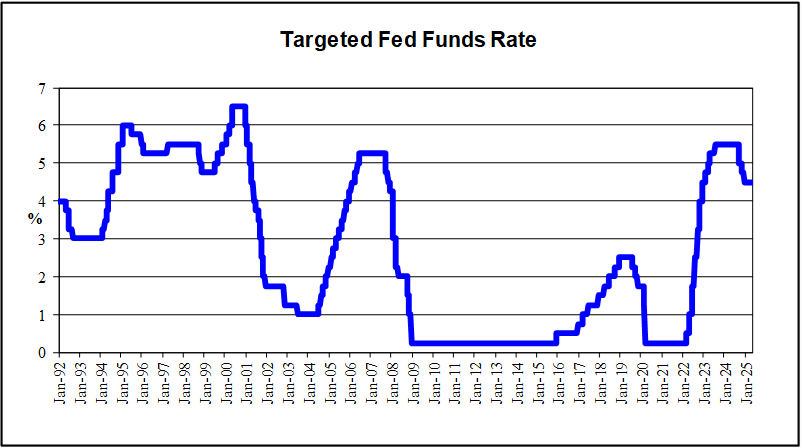
Geopolitical turmoil, trade, and fiscal policy continue to present elevated uncertainty in the outlook to the FOMC. The updated Summary of Economic Projects (SEP) median projections indicate subdued economic growth for 2025 and 2026, in addition to higher unemployment and inflation. The median levels from the latest “dot plot” maintained the 50 basis points of rate in the second half of 2025, while the cuts for 2026 and 2027 were trimmed back to one cut each year, compared to two shown previously.
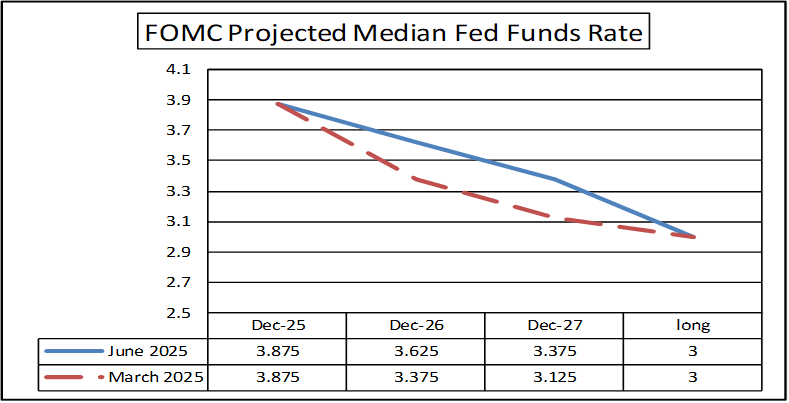
So far, tariffs have had a minimal impact on price increases. Still, it may be premature to try to observe meaningful inflationary pressure from the fluid tariff policy. Price pressures for consumer goods are expected to heat up over the coming months as business draws down existing inventory stockpiles and higher input prices start to squeeze profit margins. Both the Institute for Supply Management (ISM) and the Purchasing Managers Indexes (PMIs) have been trending higher, indicating rising price pressures in the manufacturing and the service sectors. The Federal Reserve’s Beige Book noted that their contacts expect prices and costs to rise at a faster pace moving forward and are looking to pass the costs of tariffs onto their customers.
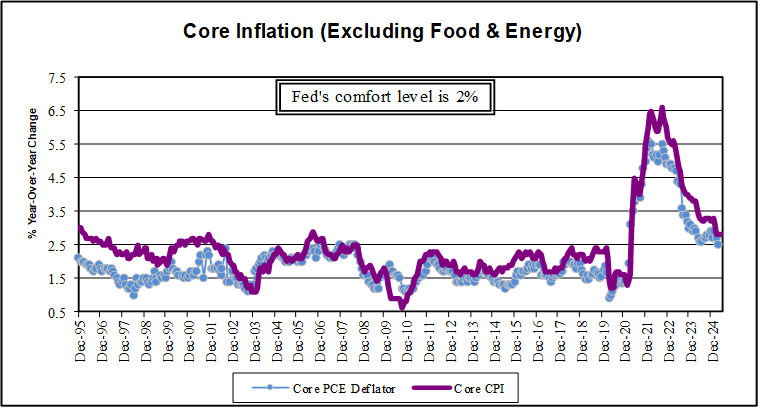
The latest employment report produced some signs of caution. While non-farm payrolls increased more than consensus, the previous two months had significant downward revisions. In the household survey, both civilian employment and the size of the labor force plummeted, and the labor force participation rate ticked down. Additionally, the latest Job Openings and Labor Turnover Survey (JOLTS) showed job openings edged higher, but remain on a downward trend while initial and continuing claims for unemployment benefits have started trending higher. The labor market is starting to struggle as businesses are warning that constantly shifting trade policies are interfering with their ability to plan, leading to hiring freezes. Protecting profit margins in the face of higher input prices and weaker demand may soon increase layoffs to cut costs.
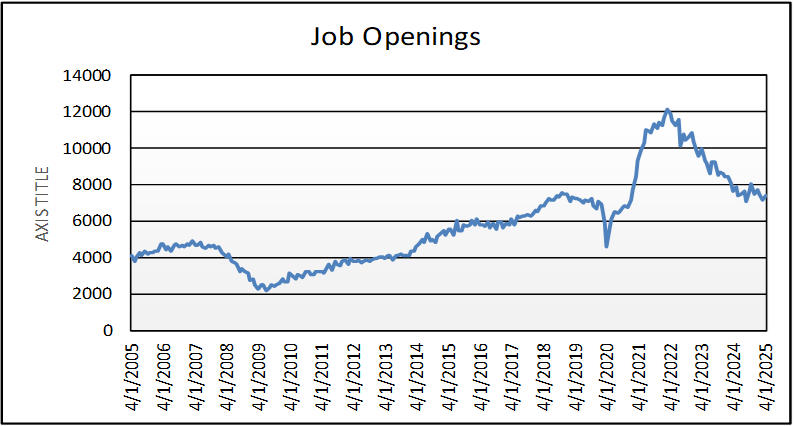
The prospect of a higher unemployment rate and rising inflation pressures are a bad combination for consumers, the primary driver of economic activity. The big question is whether tariff-induced uncertainty, job security concerns and exhaustion of covid-era excess savings will cause household spending to freeze up. Tariff related inflation is expected to negatively impact real income growth. Signs of a deceleration in retail sales and anecdotal evidence in the Federal Reserve’s Beige Book indicate that consumers are tempering their spending, which could signal slower economic growth ahead.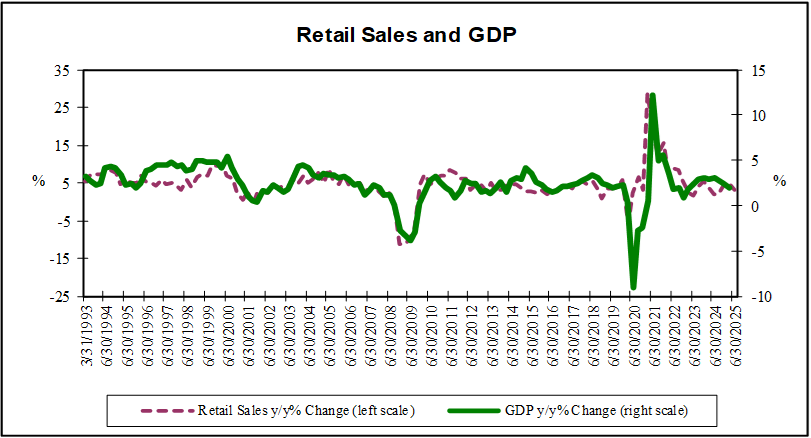
The minutes of the September 25-26 Federal Open Market Committee (FOMC) meeting reinforced the view of higher interest rate ahead as the economy continues to expand at a solid pace and inflation remains close to its 2 percent target. Economic fundamentals remain strong as evidenced by _____% annualized quarterly growth for the third quarter. While slower than the second quarter’s 4.5 percent growth rate, it is still above trend and of the Fed’s near-term plan to continue gradually lifting short-term rates. Additionally, according to the minutes, a number of participants believe that it will be necessary to raise rates above neutral temporarily to avoid overshooting inflation or contributing to financial imbalances.
Risks to the outlook were seen as roughly balanced. On the downside, trade developments, global divergence of growth prospects and stress in emerging markets were referenced in the minutes, but this was offset by high consumer and business confidence and the potential for a greater than anticipated impact from fiscal stimulus. Despite removing the word accommodative from the last policy statement the majority of FOMC members believe the federal funds rate is still below its neutral level. At 2 to 2.25 percent, the federal funds rates and money market instrument tied to the targeted rates barely or does not cover, depending on which price gauge one chooses, the annual inflation rate, meaning the real cost of money is still cheap, and accommodative.
There is an abundance of data that indicates the economy is on solid footing and will likely continue to expand in the final quarter of 2018 and the start of 2019. The August Job and Labor

Turnover Survey (JOLTS) showed job openings rose to a fresh record high. Industrial production momentum continues at its best pace with output increasing at a 5.2 percent rate, the best in nearly 8 years. The September unemployment rate has dropped to 3.7 percent, a level not seen since 1969. The Conference Board’s leading Economic Index marked its fourth consecutive monthly increase of at least 0.4 percent in September and its 28th straight month without a decline. Taken together, the odds of a recession in the hear-term appear remote.

If there is a canary in the coal mine, it is the housing sector. It is caught in the middle of some powerful headwinds. Recent data has been downbeat as rising mortgage rates and persistently rising home prices are eroding affordability. Existing home sales fell 3.4 percent in September, marking the sixth straight monthly decline. New home sales Housing starts in September declined a sharp 5.3 percent. While some of the weakness in both sales and starts can be chalked up to weather distortions builders still face constraints including available workers, high land prices and rising material prices.


 Full Fusion
Full Fusion